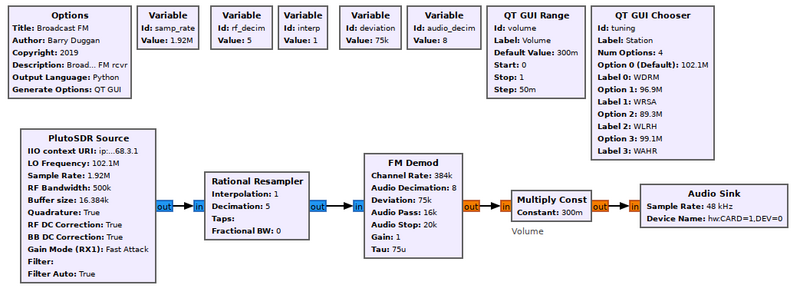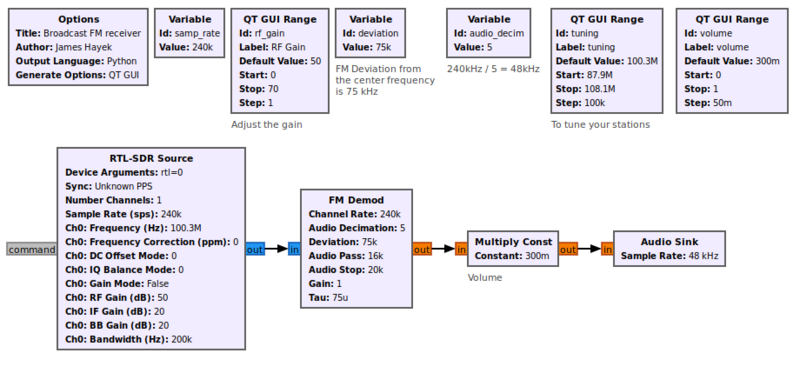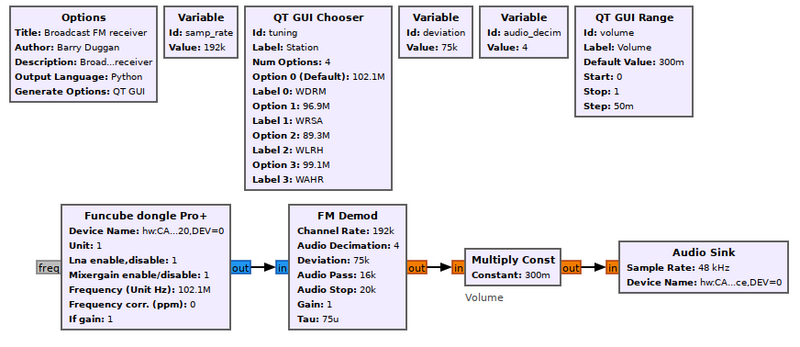User:Duggabe
DRAFT REVISION Guided_Tutorial_Hardware_Considerations
Introduction
One of the great strengths of GNU Radio is how easy it is to move from simulation to real-world operation. In this tutorial, we will build on what you have learned so far and create a complete FM radio receiver which you can use to listen to your local FM radio stations. Also we will discuss considerations that come into play when working with real-world radio hardware.
Prerequisites
- Our Suggested Reading list
- Tutorials:
What Will I Need?
Even if you don't have an actual radio to work with, this tutorial is still useful. The "Signal Processing" portion produces an FM radio with input from a pre-recorded file. To load that file, do the following steps:
- Go to https://github.com/gnuradio/gr-tutorial/blob/master/examples/tutorial6/fm_101.8MHz_1Msps.cfile in your browser and click Download.
- If not the default, select your Downloads directory.
This tutorial will be most useful, however, if you have a piece of radio hardware that you can use with GNU Radio. There are a large number of vendors who provide hardware with GNU Radio drivers. They span from very cheap $20 receivers to very high-performance tens-of-thousands-of-dollars systems. See Hardware for additional information.
Building an FM Radio Receiver
This tutorial is divided into two sections: "Signal Processing" and "Hardware". Various popular hardware devices are shown so that you can build with your available device.
In the "Signal Processing" section we will build the Software Defined Radio (SDR) portion of the flowgraph and test it. Then, using that as a base, we will "plug in" a hardware device of your choice. So, building the "Signal Processing" portion is required in any case. After that, substituting a hardware device will follow easily.
GNU Radio Signal Processing
Using gnuradio-companion (GRC) and the following Block descriptions, build this flowgraph:
Block descriptions
- The Options block identifies the filename for the flowgraph, a title, author, etc.
- id: FM_receive
- Title: Broadcast FM receiver
- enter other fields as desired
- click Apply
- click OK
- click on File -> Save As Use the file name 'FM_receive'. The extension '.grc' is added automatically
- Variable block - defines the sample rate for the flowgraph
- id: samp_rate
- value: 384000
- Variable block - defines the decimation factor for the rational resampler
- id: rf_decim
- value: 1000
- Variable block - defines the interpolation factor for the rational resampler
- id: interp
- value: 384
- Variable block - defines the FM modulation deviation in Hertz
- id: deviation
- value: 75000
- Variable block - defines the audio decimation factor for the FM demodulator
- id: audio_decim
- value: 8
- The QT GUI Range block creates an Audio gain (volume) control
- id: volume
- default value: 0.3
- start: 0.0
- stop: 1.0
- step: 0.1
- Widget: slider (or you can choose whichever you like)
- File Source - reads the pre-recorded FM station data file
- File: $HOME/Downloads/fm_101.8MHz_1Msps.cfile (use your file path; you also can browse to find the file by clicking the three dots next to the filename)
- Output Type: Complex
- Repeat: Yes
- leave the other parameters as default values
The Rational Resampler interpolates (multiplies) the sample rate by the Interpolation factor and decimates (divides) the sample rate by the Decimation factor to produce the output sample rate. In this case, the 1MB input is divided by 1000 and multiplied by 384 to produce an output rate of 384000 samples per second.
- Rational Resampler
- Type: Complex -> Complex (Complex Taps)
- Interpolation: interp
- Decimation: rf_decim
- Taps: leave blank
- Fractional BW: 0
- FM Demod - the 384kHz input signal is demodulated and then decimated by 8 to produce a 48kHz signal for the Audio Output.
- Channel Rate: samp_rate
- Audio Decimation: audio_decim
- Deviation: deviation
- Audio Pass: 16000
- Audio Stop: 20000
- The value of the volume control is used as a multiplier in the Multiply Const block.
- IO Type: float
- Constant: volume
- The speaker output is created by an Audio Sink block. The parameters are:
- Sample rate: set to 48kHz (use the pull-down)
- Device name: for most speakers (or headphone jacks) built into the computer, the Device name can be left blank; for other cases, see Audio_Sink#Device_Name
- OK to Block: Yes
TESTING: See Testing section below.
Hardware Front End
Now that you have gotten this far, you need to save a copy of your flowgraph before proceeding.
- click on File -> Save Copy
That way you will have the baseline flowgraph if you choose to use a different hardware device (or to start over).
Preparation for hardware
For each of the hardware blocks presented below, we will be replacing the File Source block with a hardware block. In addition, four of the five Variable blocks may need to have new values.
Also, for the Audio Sink block, set:
- OK to Block: No
ADALM-PLUTO
The ADALM-PLUTO (PlutoSDR) is a portable, self-contained RF learning module which is supported by GNU Radio source and sink blocks. It can operate from 70MHz to 3.8GHz.
Using gnuradio-companion (GRC) and the following Block descriptions, build this flowgraph from our "Signal Processing" baseline.
The actual source and sink blocks are created by an 'Industrial I/O' module. See https://wiki.analog.com/resources/tools-software/linux-software/gnuradio for details.
- Delete the File Source block and replace it with a PlutoSDR Source block. Set the parameters as follows:
- IIO context URI: "ip:192.168.2.1" (without the quotes)
- LO Frequency: tuning
- Sample Rate: samp_rate
- RF Bandwidth: 500000
- Buffer size: 16384
- Quadrature: True
- RF DC Correction: True
- BB DC Correction: True
- Gain Mode (Rx1): Fast Attack
- Filter: (leave blank)
- Filter Auto: True
- Add a QT GUI Chooser block for the tuning control
- id: tuning
- Label: Station
- Type: int
- Num Options: 4
- Option 0 (Default): 102100000 (enter your favorite FM stations for all of these)
- Label 0: WDRM
- Option 1: 96900000
- Label 1: WRSA
- Option 2: 89300000
- Label 2: WLRH
- Option 3: 99100000
- Label 3: WAHR
- Widget: Radio Buttons
- Orientation: Horizontal
Change the following Variable block values.
- Variable block - defines the sample rate for the flowgraph
- id: samp_rate
- value: 1920000
- Variable block - defines the decimation factor for the rational resampler
- id: rf_decim
- value: 5
- Variable block - defines the interpolation factor for the rational resampler
- id: interp
- value: 1
- Variable block - defines the audio decimation factor for the FM demodulator
- id: audio_decim
- value: 8
TESTING: See Testing section below.
UHD / USRP
The USRP B200 provides a fully integrated, single board Universal Software Radio Peripheral platform with continuous frequency coverage from 70 MHz to 6 GHz.
Using gnuradio-companion (GRC) and the following Block descriptions, build this flowgraph from our "Signal Processing" baseline.
- Delete the File Source block and replace it with a UHD: USRP Source block. Set the parameters as follows:
- General Tab
- Output Type: Complex float32
- Wire Format: Automatic
- Stream args: (blank)
- Stream channels: []
- Device Address: "serial=xxxxxx" (supply your serial number)
- Device Arguments: ""
- Sync: No Sync
- Clock Rate (Hz): Default
- Num Mboards: 1
- Mb0: Clock Source: Default
- Mb0: Time Source: Default
- Mb0: Subdev Spec: (blank)
- Num Channels: 1
- Samp rate (sps): samp_rate
- Advanced Tab
- Show LO Controls: False
- RF Options Tab
- Ch0: Center Freq (Hz): tuning
- Ch0: AGC: Enabled
- Ch0: Antenna: TX/RX
- Ch0: Bandwidth (Hz): 500000
- General Tab
- Add a QT GUI Range block for the tuning control
- id: tuning
- Label: Frequency
- Type: int
- default value: 102100000 (enter your favorite FM station)
- start: 88000000
- stop: 108000000
- step: 200000
- Widget: Counter + Slider (or you can choose whichever you like)
Change the following Variable block values.
- Variable block - defines the sample rate for the flowgraph
- id: samp_rate
- value: 1920000
- Variable block - defines the decimation factor for the rational resampler
- id: rf_decim
- value: 10
- Variable block - defines the interpolation factor for the rational resampler
- id: interp
- value: 1
- Variable block - defines the audio decimation factor for the FM demodulator
- id: audio_decim
- value: 4
TESTING: See Testing section below.
RTL-SDR dongle
The RTL-SDR is a receive-only, low-cost, self-contained RF signal tuner supported by GNU Radio. There are several varieties of this device; the one used in this section is the V.3 Model. The full description is RTL2832U R820T2 TCXC + BIAS T + HF. The device has a frequency range of 500 kHz to 1766 MHz, with operation from 500 kHz to 24 MHz in direct sampling mode. The spec sheet can be found here.
Using gnuradio-companion (GRC) and the following Block descriptions, build this flowgraph from our "Signal Processing" baseline.
The source block is created by an Out of Tree module. See https://github.com/osmocom/gr-osmosdr for details.
- Delete the File Source block and replace it with an OsmoSDR RTL-SDR Source block. Set the parameters as follows:
(TBD)
FunCube Pro+
The FunCube Pro+ is a small, receive only USB "dongle" with a range of 150kHz to 240MHz and 420MHz to 1.9GHz.
Using gnuradio-companion (GRC) and the following Block descriptions, build this flowgraph from our "Signal Processing" baseline.
The source block is created by an Out of Tree module. See https://github.com/dl1ksv/gr-fcdproplus for details.
- Delete the File Source block and replace it with a FunCube dongle Pro+ block. Set the parameters as follows:
- Device Name: (see Audio_Source#Device_Name for details)
- Unit: 1
- Lna enable, disable: 1 (enables low noise amplifier)
- Mixer gain enable, disable: 1
- Frequency (Unit Hz): tuning
- Frequency corr. (ppm): 0 (frequency correction in parts per million)
- If gain: 1
Since the fixed sample rate of the FunCube Pro+ is 192kHz, there is no need to decimate it before input to the FM Demod block. Therefore the Rational Resampler can be removed.
- Add a QT GUI Chooser block for the tuning control
- id: tuning
- Label: Station
- Type: int
- Num Options: 4
- Option 0 (Default): 102100000 (enter your favorite FM stations for all of these)
- Label 0: WDRM
- Option 1: 96900000
- Label 1: WRSA
- Option 2: 89300000
- Label 2: WLRH
- Option 3: 99100000
- Label 3: WAHR
- Widget: Radio Buttons
- Orientation: Horizontal
- Variable block - defines the sample rate for the flowgraph
- id: samp_rate
- value: 192000
- Variable block - defines the audio decimation factor for the FM demodulator
- id: audio_decim
- value: 4
Testing
Using GRC, click the Run icon or click Run -> Execute from the menu. After a few seconds, a GUI window will open with the Volume control (and Chooser or slider). You should hear the radio station. If the GUI window doesn't appear, look at your terminal screen for error messages.
If the sound is distorted or has interruptions, try the following:
- adjust the rf_gain setting
- For the Audio Sink block, change OK to Block
To terminate the process cleanly, click on the 'X' in the upper corner of the GUI window rather than using Control-C.
Further Study
Once you have a working radio, you can experiment with different settings.
- sample rate
- band width
- RF gain - manual or AGC
If you add a QT GUI Sink block connected to the source block, you will get plots of Frequency, Time, Waterfall, and Constellation.




